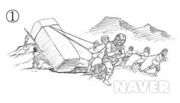GGHS 2019 Winter - Team 2
Write introduction about topic here.
목차
Team
| No. | Team Topic | Teacher | Role | Name (Korean) | No. of Students |
|---|---|---|---|---|---|
| 2 | Dolmens of Ganghwa (강화의 고인돌) |
Evgeniia POLUMESTNAIA | Leader | 정가인 | 7 |
| Vice-Leader | 박진아 | ||||
| 홍지현 | |||||
| 심여빈 | |||||
| 홍연재 | |||||
| 이서현 | |||||
| 류가람 |
Ganghwa and the Dolmen
In our team, our main subject is 'Ganghwa and the Dolmen' . And For better
Dolmens in Bugeun-ri, Ganghwa
"Dolmens can be found alone or in groups. There are five dolmen groups on Ganghwado, among which is this group of 16 dolmens in Bugeun-ri. The largest one, standing alone in the field next to the paved road, is designated as Historic Site No. 137. Other dolmens distributed around the pine trees are either table type or unsupported capstone type. Table type dolmens are comprised of upright, stone slabs covered by a wide, flat capstone to create an above-ground burial chamber. Unsupported capstone type dolmens are comprised of a capstone on top of an underground stone burial chamber." [1]
The kinds of Dolmens
What Kind Of Worth Does Dolmens Have To People In Ganghwa
The Definition of Dolmens
Rolls of Dolmen
Although there were many controversies over the function of the dolmen on the Korean Peninsula, it was confirmed that the stone was made for the purpose of the tomb in 1967 when the complete human bones were discovered at Hwangseok-ri Dolmen in Jecheon, North Chungcheong Province. However, some argue that the tomb was not just a function of the tomb. Although there is no objection to the fact that the tomb functioned as a tomb, some argue that the stone was made as a function of an altar or tombstone in addition to the tomb. Claiming the function of the altar, the table dolmen might have served as an altar rather than a tomb, citing the fact that they are located higher than the surrounding area so that people can easily see, and the appearance of grandeur on the pedestal, and the structure of the pedestal, which is difficult to form a tomb. In addition, in the case of a group of dolmen, sometimes the dolmen can be seen to be unusually large or different in direction than other dolmen, which is presumed to be a simple function that was built to reveal the authority and prestige of the tomb-building group
The Process Of Construction

Map(s)
Network Graph(s)
- SAMPLE: VH2018_부석사reference.lst
- YOUR TEAM GRAPH: GGHS2019W_Team2.lst
References
- 인천광역시 문화유산 - 영문 해설문 포함 (한국학중앙연구원)
